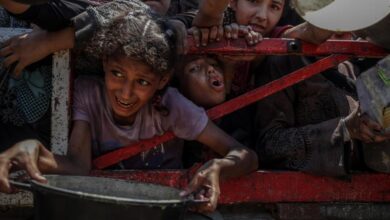EL ADOW, Kenya – A besuited UN official wearing well-buffed shoes crouches in the orange dust near a cluster of huts in northern Kenyan, and, as his tie wafts in the breeze, raises an iPad and carefully films the rotting carcass of a cow.
Since drought gripped the Horn of Africa, and especially since famine was declared in parts of Somalia, the international aid industry has swept in and out of refugee camps and remote hamlets in branded planes and snaking lines of white 4X4s.
This humanitarian, diplomatic and media circus is necessary every time people go hungry in Africa, analysts say, because governments – both African and foreign – rarely respond early enough to looming catastrophes.
Combine that with an often simplistic explanation of the causes of famine, and a growing band of aid critics say parts of Africa are doomed to a never-ending cycle of ignored early warnings, media appeals and emergency UN feeding – rather than a transition to lasting self-sufficiency.
"Although humanitarian agencies are gearing themselves up to mount a response, it is far too late to address anything but the worst symptoms," Simon Levine, an analyst at the Overseas Development Institute think-tank, wrote on its website.
"Measures that could have kept animals alive – and providing milk, and income to buy food – would have been much cheaper than feeding malnourished children, but the time for those passed with very little investment," Levine said.
The drought gripping the region straddling Somalia, Kenya and Ethiopia is the worst for 60 years, some aid groups say, and is affecting more than 12 million people. In the worst-hit area in Somalia, 3.7 million people are at risk of starvation.
"It seems once again that slow onset disasters don't get attention until they become critical," said a senior humanitarian adviser at a UN agency in the region.
"One can understand this with rapid onset disasters as they come out of the blue, but drought…we've seen it before and we will again," said the official, who declined to be named.
The man filming the dead cow with an iPad was just one in a series of incongruous episodes when the director of the UN food agency, Josette Sheeran, flew for a day-trip to a small village and the world's biggest refugee camp in Dadaab to see how her organization is delivering emergency food.
Sheeran posed awkwardly next to the dead carcasses, an uneasy almost-smile on her lips as her staff snapped away with cameras and phones, watched by bemused locals.
Officials then had stilted conversations with refugees used to answering questions from Western aid workers who come with sometimes sympathetic nods, always promising that they can make things better.
"While international NGOs can be very active around humanitarian response many of them don't have a long-term development strategy for these areas," Andrew Catley, an expert on the Horn of Africa at the Feinstein International Center at Tufts University, told Reuters.
THORNY POLITICS
Reporters accompanied Sheeran, knowing they might need the iconic, loathed-by-Africans footage of the most emaciated babies they could find to get air time, or chance upon the "haunted" mother with the most dead children.
For many analysts, however, the story being told in the Horn of Africa by the humanitarian and media caravan is simplistic and misleading.
There is clearly a drought, they say, but the reason tens of thousands of people are leaving their homes in search of food is also because a festering insurgency in Somalia – along with the forced recruitment of youths – is making things worse.
Much of southern and central Somalia is controlled by al-Shabab Islamist militants linked to Al-Qaeda who imposed a ban on food aid in 2010. They have since lifted the ban but maintained the embargo on the WFP, calling it a "spy agency."
"This is not political," Sheeran briefed frontline aid workers in northern Kenya, saying that responding to the crisis was all that mattered now. "It's about saving lives."
Al Shabaab accused the United Nations last week of exaggerating the severity of the drought and said it would not allow agencies with "hidden agendas" to return.
Part of the problem, analysts say, is that much of the funding for WFP, and some other aid agencies, comes from the United States, opening them to charges of skewed objectives.
"What they are really interested in is security in Somalia. Since 9/11 a development for security agenda has come in with big donors like USAID and (Britain's) DFID," said a former senior aid worker in the Horn of Africa.
"Humanitarian issues and real development have basically played second fiddle to their security agendas," he said.
The State Department website says that although USAID is independent, it "receives general direction and overall foreign policy guidance from the Secretary."
According to WFP's website, the United States has contributed 45 percent of its government funding since the start of 2007 – or US$7.3 billion out of US$16.3 billion.
Analysts say that, without tackling the political complications that influence the distribution of food aid, and even the use of the word "famine," droughts will remain difficult both to prevent and to manage.
"Whilst it is tempting to say that the causes of the crisis are natural causes, it's much more difficult to look at the man-made causes of the crisis such as governance, conflict and economic trends," Catley said.
Several senior aid officials spoken to by Reuters did not want to be named when criticizing the aid system for fear of losing their jobs or being banned entry by African governments, but said the industry desperately needed an overhaul.
"Some of these organizations have been in these regions for 20/25 years and they're doing the same things today that they were doing 25 years ago," one said.
"If you were in any other sector – and you had such a terrible impact – you'd be out of business."



